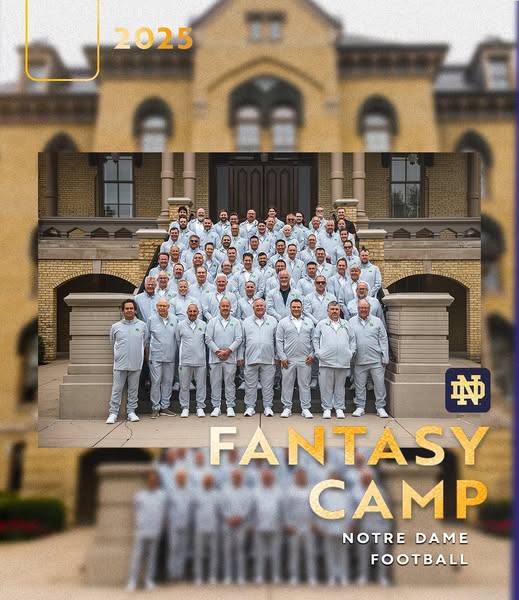Few programs in college football can match the pageantry, mystique, and legacy of Notre Dame. From Knute Rockne to the Gipper, the echoes have long been stirred in South Bend, Indiana, where Saturdays are sacred and golden helmets shine like polished relics from another era. But beyond the wins, Heisman trophies, and national titles, there exists a deeper fabric — a culture, a heartbeat, a tradition unlike any other. And it’s not just the victories or the trophies. It’s the way the community moves in rhythm with the team, the way rituals transcend time, and how each new generation of players doesn’t just inherit a jersey, but a sacred calling.
At Notre Dame, football is more than a sport. It’s a living, breathing tradition woven into the soul of the university. When fans talk about “Notre Dame Football,” they’re referring to something far greater than the game. It’s the pregame Mass at the Basilica of the Sacred Heart. It’s the trumpets under the Dome playing the alma mater. It’s the way the team walks from the Guglielmino Athletics Complex to the stadium, surrounded by fans of all ages, reaching out for a momentary connection to greatness.
It begins with the bells. As morning breaks over campus on a game day, there’s a buzz in the air — not of urgency, but of ceremony. Students emerge in green and gold. Alumni return like pilgrims. The echo of chants, distant but growing, carries through the Indiana air. From the first toll of the Basilica’s bells to the final whistle echoing inside Notre Dame Stadium, every moment is steeped in ritual.
Players prepare, but not in isolation. They visit the Grotto of Our Lady of Lourdes, where quiet reflection meets firelight. Candles flicker in rows — offerings from players, coaches, and fans alike. For many, this small stone sanctuary holds as much meaning as the stadium itself. Before the roar of 80,000 fans, there is silence. Before war, there is prayer.
And then there’s the walk — a tradition that stirs emotion even before kickoff. Known as the Player Walk, it’s a slow, deliberate march through campus that transforms athletes into vessels of Notre Dame’s past and present. Crowds gather hours early, lining the path, not to shout or taunt or plead for autographs, but to honor. For those few minutes, each player becomes a bearer of the program’s legacy. They wear suits and ties, no pads, no helmets — just purpose. They pass the Grotto, the Basilica, and finally reach the stadium, a cathedral of football where legends are born and remembered.
Notre Dame Stadium itself is hallowed ground. It is where Touchdown Jesus watches from afar, arms raised in eternal celebration. Built in 1930 and renovated in modern times without losing its soul, the stadium isn’t flashy. It doesn’t boast the largest screen or the loudest sound system. What it has instead is a sense of reverence. It feels like a place of destiny. Fans don’t just arrive — they enter. They don’t just cheer — they believe.
And when the team runs out of the tunnel, touching the famous “Play Like a Champion Today” sign along the way, the stadium explodes — not in chaos, but in unity. That sign, simple in its phrasing, carries weight no coach could manufacture. Legends have tapped it. Champions have followed it. Every time a player’s fingers brush against it, they aren’t just promising effort; they are accepting a challenge that generations have embraced before them.
The band, the oldest university marching band in continuous existence, begins to play. The Victory March rings out — not just a fight song, but a battle cry. And unlike at many other stadiums, it’s not just the student section that knows the words. Grandparents sing it. Children belt it out. It’s a communal anthem, and it reverberates through the hearts of every Notre Dame fan scattered across the world.
But perhaps what makes Notre Dame Football’s tradition truly unlike any other is its ability to blend the sacred with the spirited. The Fighting Irish mascot dances with the band. The crowd chants “We Are ND” with ferocity. Yet after every game, win or lose, the team gathers at the student section, removes their helmets, and sings the alma mater. “Notre Dame, Our Mother,” they sing, in solemn harmony. Fans join. Opponents stand in quiet respect. It’s not performative. It’s devotional.
This fusion of football and faith, passion and humility, is what separates Notre Dame from the rest. Other programs have great traditions, no doubt. But at Notre Dame, the tradition isn’t just the object of nostalgia or celebration — it is the foundation of everything. It’s why recruits are moved to tears during campus visits. It’s why former players return not just to be seen but to remember. And it’s why, when people speak of the “Notre Dame Family,” they do so with conviction.
There’s also the mythology — stories passed down like sacred texts. The Four Horsemen riding into immortality, captured by Grantland Rice’s pen. Rudy Ruettiger sacking the quarterback and being carried off the field. Joe Montana coming back from hypothermia in the Cotton Bowl. The Snow Bowl. The Bush Push. The epic battles against Michigan, USC, and Miami. These aren’t just games — they’re chapters in a never-ending novel of struggle and glory.
Every era brings its own heroes and heartbreaks. From the precision of Ara Parseghian’s dominance to the electricity of Lou Holtz’s national title run, to Brian Kelly’s return to consistent contention — each coach, each season, each Saturday adds to the lore. But the tradition remains. Unshaken. Unyielding.
And then there’s the helmet — that gleaming dome of gold, painted with flakes that reportedly come from the Golden Dome itself. It’s not a uniform piece. It’s a crown. Opposing players and coaches frequently note how intimidating that glinting gold can be under the lights. But for Notre Dame players, it’s not about intimidation. It’s about inheritance. They wear it not because they’re the best in the country, but because they’ve committed to becoming the best version of themselves — on and off the field.
Notre Dame also holds firm to independence. In an age of realignment and revenue-chasing, the Irish remain unaffiliated — beholden to no conference, answerable only to their own tradition. Some call it arrogance. Others call it purity. At Notre Dame, it’s simply identity. The ability to shape your own schedule, to face the best, and to do so without compromise — it’s not just about football strategy. It’s about standing firm in who you are.
Even the weather seems to understand its role in South Bend. There’s something about a gray sky over Notre Dame Stadium that feels cinematic. Rain? Snow? Cold? It doesn’t matter. The game goes on, and the echoes stir louder. It’s no surprise that some of the most unforgettable moments in program history came during less-than-ideal conditions. It’s as if nature conspires with fate to heighten the drama.
And so, when someone says “Notre Dame Football,” they’re speaking of something ancient and alive. They’re speaking of courage and commitment, sacrifice and spirituality. They’re speaking of a tradition that doesn’t just exist on fall Saturdays, but all year long, in classrooms and locker rooms, in alumni clubs and watch parties, in the hearts of every young child who dreams of someday wearing that jersey, walking that path, and touching that sign.
It’s why, every year, no matter the rankings or predictions, Notre Dame is always part of the conversation. Because they are not just chasing wins. They are upholding something sacred. And while trophies gather dust, and banners fade, the tradition lives on — carried in the voices of fans, the prayers of students, the memories of alumni, and the dreams of those yet to arrive.
A Notre Dame football tradition unlike any other doesn’t ask for applause. It asks for reverence. It doesn’t scream its greatness — it lives it. And as long as the bells ring, the candles burn, and the team walks beneath that sign, the tradition will remain, stronger than ever, unbroken and eternal.



